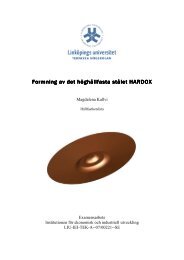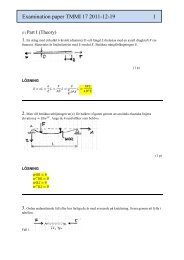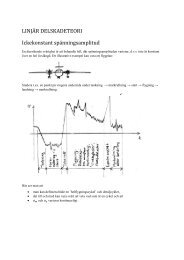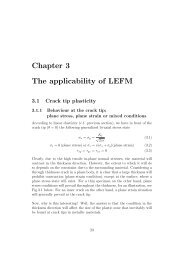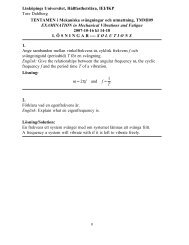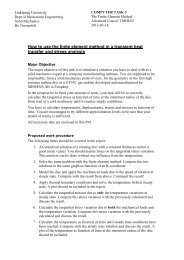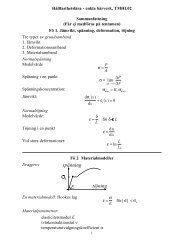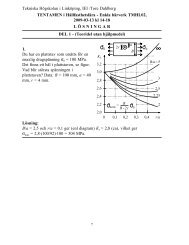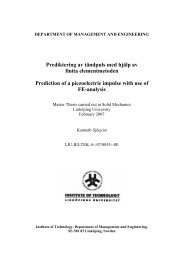2003-01-18 - Division of Solid Mechanics
2003-01-18 - Division of Solid Mechanics
2003-01-18 - Division of Solid Mechanics
Create successful ePaper yourself
Turn your PDF publications into a flip-book with our unique Google optimized e-Paper software.
Examination in Damage <strong>Mechanics</strong> and Life Analysis (TMHL61)<br />
LiTH <strong>2003</strong>-<strong>01</strong>-<strong>18</strong><br />
Part 1<br />
3. (1 point) Constant-amplitude fatigue strengths for materials<br />
subjected to different cyclic loading conditions are<br />
<strong>of</strong>ten expressed in Haigh diagrams. Consider the five<br />
a<br />
loading cases where the loading varies sinusoidally<br />
A<br />
and<br />
1. the mean value σ m is constant,<br />
200<br />
100<br />
B 2. the amplitude σ a is constant,<br />
3. the maximum value σ max (= σ m + σ a ) is constant,<br />
0<br />
0<br />
m<br />
100 200 300 400 MPa<br />
4. the minimum value σ min (= σ m − σ a ) is constant,<br />
and<br />
5. the stress ratio R = σ min /σ max is constant.<br />
In the Haigh diagram given, two straight lines (A<br />
and B) are shown. For each line one <strong>of</strong> the five<br />
loading conditions applies.<br />
(a) Determine which one <strong>of</strong> the five loading variables is constant for line A shown in<br />
the figure (i.e., match line A to one <strong>of</strong> the five loading conditions). Explain your choice.<br />
(b) Determine which one <strong>of</strong> the five loading variables is constant for line B shown in<br />
the figure (i.e., match line B to one <strong>of</strong> the five loading conditions). Explain your choice.<br />
Solution and answer here:<br />
For line A one notices that σ m + σ a is a constant (= 300 MPa). Thus, line A gives that<br />
stress σ max is constant.<br />
For line B one notices that σ m − σ a = σ min is constant (= 200 MPa). Thus, stress σ min is<br />
constant.<br />
Answer:<br />
(a) Line A: stress σ max is constant, (b) line B: stress σ min is constant.<br />
4. (1 point)<br />
To determine the fatigue limit <strong>of</strong> a material, the so-called stair-case method is<br />
sometimes used. Explain the principles, requirements and assumptions <strong>of</strong> this method<br />
(no formulas are needed).<br />
Solution and answer here:<br />
The fatigue testing is performed so that if a test specimen fails (due to fatigue), the next<br />
specimen will be tested at a lower stress level. If it does not fail (becomes a run-out),<br />
the next specimen will be tested at a higher stress lever. Then, assuming that the yield<br />
limit has a normal distribution, and knowing the number <strong>of</strong> failures and run-outs at each<br />
stress level, the mean value and the standard deviation <strong>of</strong> the fatigue limit can be<br />
estimated. This requires that tests performed at a stress level too far away from the<br />
mean value should be rejected.<br />
7 <strong>2003</strong>-<strong>01</strong>-23/TD




